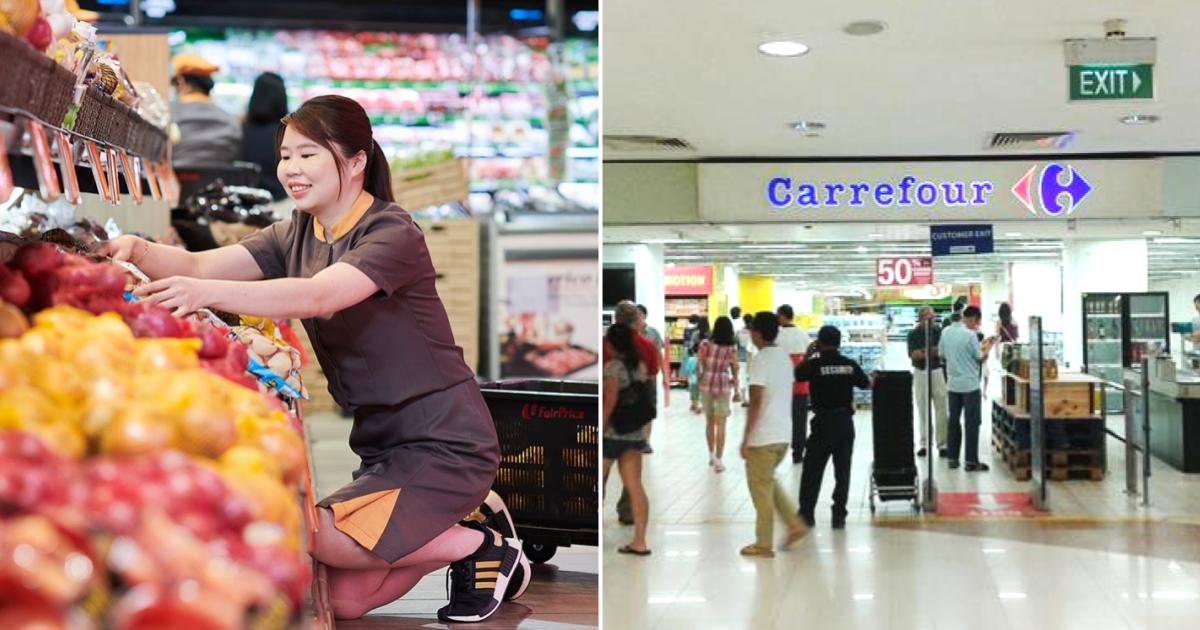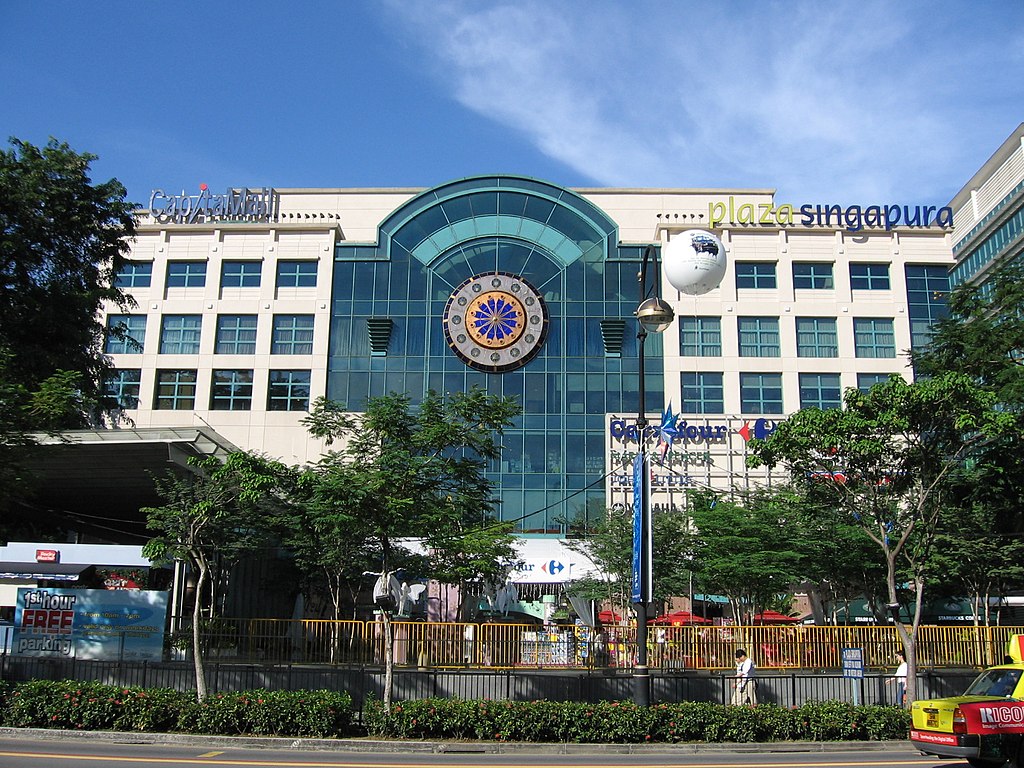How 'local leader' FairPrice defended S'pore home turf & saw 'global giant' Carrefour exit in 15 years
Carrefour had ambitious plans when it entered Singapore in 1997.
Mothership
Supermarket brand Carrefour made waves when it entered Singapore in 1997, aiming for five hypermarkets in as many years. Even for the French retail giant, establishing itself here was no walk in the park — it had to face off with homegrown incumbent FairPrice, among other competitors.
The two chains fought it out, trying to outbid each other to rent retail space, dangling promotions and lower prices, and even conducting covert reconnaissance at each other’s stores.
FairPrice eventually outlasted its rival, seeing off the competition when Carrefour's Suntec City Mall hypermarket closed its shutters for good in late 2012.
It's one of the stories told in a new book, The Price of Being Fair, written following interviews with current and former leaders in FairPrice and the labour movement, complemented by unprecedented access to FairPrice's archives. It tells the story of the co-operative's successes, as well as failures over half a century – from aborted retail concepts to loss-making overseas ventures.
The book was edited by Sue-Ann Chia and Peh Shing Huei, and published by The Nutgraf Books. You can get a copy of it here, or at Books Kinokuniya, Times, and Popular bookstores from Monday, Jul. 10.
The following excerpt is taken from Chapter 6 of the book, titled Supermarket Wars I: Carrefour vs FairPrice.
By Sue-Ann Chia, Peh Shing Huei, Samantha Boh, Justin Kor, Derek Wong, Toh Wen Li, and Puah Rui Xian
For FairPrice, the tussle with Carrefour threatened to upend its status as top dog.It already reigned supreme in Singapore’s supermarket scene in the mid-1990s, then enjoying a 50 per cent market share. A total of 60 stores dotted the island, drawing an enormous membership base of over 350,000 loyal customers. But it was about to face its greatest competition, when Carrefour announced that it was expanding to Singapore.
No superlative would have been enough to describe the gulf between the two retailers. While FairPrice was a local leader, Carrefour was a global giant.
At that time, the French retailer operated over 250 outlets worldwide, having also established a firm foothold in Asia with 33 stores across mainland China, Hong Kong, Malaysia, Taiwan, and Thailand. Its net income in 1997 amounted to almost S$12 billion, making FairPrice’s turnover of S$720 million that year look like chump change.
It was a classic case of David versus Goliath, with FairPrice as the underdog fighter David against the giant Goliath that was Carrefour.
But beyond the numbers, it was Carrefour’s signature concept that posed the biggest threat. Its worldwide success had been built on operating enormous hypermarkets – a retail format that not only offered the usual fare of groceries and essentials, but also the likes of electronics, appliances, and clothing. In essence, it was a supermarket on steroids.
The chain was also already well-known among Singaporeans who made their grocery runs at its Johor Bahru outlet in Malaysia, accounting for 40 per cent of its sales. Now, it was headed across the Causeway. It struck genuine fear in FairPrice.
“When Carrefour just landed, it was like an intrusion by aliens into Singapore,” said former Group Chief Executive Officer (CEO) Tan Kian Chew. “It was a jolt to the whole supermarket industry. They were among the world’s top 10 operators – very big and very aggressive.”
Carrefour’s confidence was indeed sky-high. So high that it announced an ambitious plan to open five hypermarkets in Singapore within five years – even before its first outlet had opened.
“Each new town has about 40,000 housing units. That is more than enough to support a hypermarket,” Carrefour Singapore’s Managing Director Bernard Rolland bullishly told The Straits Times (ST) in 1997.
It also made a bold guarantee: prices at its stores would be the lowest in town, at 10 to 30 per cent below its rivals. If customers found cheaper products elsewhere within 15 days, Carrefour would refund the difference in cash.
It hit FairPrice right at the core – the social mission of providing affordable essentials to its customers was now being threatened.
Drawing on its worldwide network, the French grocer had the economies of scale to make this happen.
“Carrefour had a big advantage,” noted Chandra Das, NTUC Chairman from 1993 to 2005. “They are a big company, so they can buy (products) at a much lower price than us.” Das would make it his personal mission to prevent the retailer from planting its flag in Singapore.
When Carrefour’s first outlet opened at Suntec City to much fanfare in October 1997, the home side watched on uneasily.
“We were concerned, just as any local retailer would be afraid of any big boy that comes to their shores,” recalled Seah Kian Peng, who joined FairPrice as Chief Operating Officer in 2001 and became CEO in 2010.
The only option was to counterattack.
“You’ve got no choice but to meet them head-on,” said Tan, “This is our home country. You cannot pack up and go.” David would bring the fight to Goliath.
Mounting a counterattack
While FairPrice attacked, it also defended. The supermarket built protective moats around its home turf – the heartlands.“They had plans to open up more outlets, and we had plans to block them,” revealed Tan. A month after its debut, Carrefour opened another battlefront in Singapore’s northeast: Hougang. It was close to securing a lease for Hougang Point (now known as Hougang 1), a 110,000 sqft shopping mall then being built by Singapore’s largest developer Far East Organization.
In fact, the deal had unofficially been sealed. The mall was already being retrofitted for the hypermart, with travelators – one of the key features of a Carrefour store – already built. “All Carrefour specifications, all done,” said Das.
A Carrefour store in the suburbs was something that FairPrice could not afford to see come true. Its presence could potentially spell the end of the local supermarket chain’s dominance. Carrefour had to be stopped by any means necessary. So Das took drastic action by securing a meeting with Far East’s head honcho.
“I said, ‘I’ll match whatever Carrefour offers’,” disclosed Das. FairPrice eventually put in a bid for the same spot.
When the developer failed to come to an agreement with Carrefour on technical terms and conditions, it offered Hougang Point to FairPrice.
But it came at a cost. “We had no choice,” said Tan. “It was a painful decision – the rent was high. We had to rent the whole shopping complex, not just the hypermarket space we were operating in. We had to bite the bullet, take it, and operate it.”
As the space was too large for just a regular supermarket, FairPrice had to find retail tenants for the extra space. But the chief aim of thwarting their archrival was accomplished.
Losing the mall proved a crucial blow to Carrefour’s expansion dream. “If Carrefour had gotten Hougang Point, my guess is they would’ve gotten a few more, and they would have stayed,” remarked Das.

Lumbering on for the next nine years, the surrender finally came in 2012 when Carrefour announced that it was pulling out of Singapore. The reason: it did not see itself growing to be the market leader, having failed to dislodge FairPrice from its position.
“In the hypermarket business, if you don’t have the economy of scale of at least five good outlets, you are unlikely to make any money,” noted Tan.
FairPrice had successfully fended off its biggest threat. By denying Carrefour an early victory in Hougang back in 1997, they had delivered a crucial blow to their plans.
The homegrown player had achieved the unthinkable. It had met a global titan and prevailed.


